Source Attribution Analysis of an Ozone Concentration Increase Event in the Main Urban Area of Xi’an Using the WRF-CMAQ Model
Abstract
:1. Introduction
2. Data and Methods
2.1. Data Sources
2.2. Model Application
2.2.1. WRF-CMAQ
2.2.2. CMAQ-ISAM
3. Results and Discussion
3.1. Characterization of O3 Concentration Based on Observed Data
3.2. Model Evaluation Performance
3.2.1. Evaluation of WRF Performance
3.2.2. CMAQ Performance Evaluation
3.3. Source Analysis of O3
3.3.1. Contribution of BCONs
3.3.2. O3 Source Apportionment of Regions in d02
3.3.3. O3 Source Apportionment of Emissions in d02
3.3.4. O3 Source Apportionment of Regions in d03
3.3.5. O3 Source Apportionment of Emissions in d03
3.4. Discussion of Results
4. Conclusions
Supplementary Materials
Author Contributions
Funding
Institutional Review Board Statement
Informed Consent Statement
Data Availability Statement
Conflicts of Interest
References
- Lu, B.; Zhang, Z.; Jiang, J.; Meng, X.; Liu, C.; Herrmann, H.; Chen, J.; Xue, L.; Li, X. Unraveling the O3-NOX-VOCs Relationships Induced by Anomalous Ozone in Industrial Regions during COVID-19 in Shanghai. Atmos. Environ. 2023, 308, 119864. [Google Scholar] [CrossRef] [PubMed]
- Wang, S.; Niu, Y.; Zhang, H.; Zhao, Z.; Zhang, X. Metabolomic Alterations in Healthy Adults Traveling to Low-Pollution Areas: A Natural Experiment with Ozone Exposure. Sci. Total Environ. 2023, 897, 165501. [Google Scholar] [CrossRef] [PubMed]
- Seiwert, B.; Nihemaiti, M.; Troussier, M.; Weyrauch, S.; Reemtsma, T. Abiotic Oxidative Transformation of 6-PPD and 6-PPD Quinone from Tires and Occurrence of Their Products in Snow from Urban Roads and in Municipal Wastewater. Water Res. 2022, 212, 118122. [Google Scholar] [CrossRef] [PubMed]
- Agathokleous, E.; Feng, Z.; Oksanen, E.; Sicard, P.; Wang, Q.; Saitanis, C.J.; Araminiene, V.; Blande, J.D.; Hayes, F.; Calatayud, V.; et al. Ozone Affects Plant, Insect, and Soil Microbial Communities: A Threat to Terrestrial Ecosystems and Biodiversity. Sci. Adv. 2020, 6, eabc1176. [Google Scholar] [CrossRef]
- Mills, G.; Pleijel, H.; Malley, C.S.; Sinha, B.; Cooper, O.R.; Schultz, M.G.; Neufeld, H.S.; Simpson, D.; Sharps, K.; Feng, Z.; et al. Tropospheric Ozone Assessment Report: Present-Day Tropospheric Ozone Distribution and Trends Relevant to Vegetation. Elem.-Sci. Anthr. 2018, 6, 47. [Google Scholar] [CrossRef]
- Song, X.; Hao, Y. An Assessment of O3-Related Health Risks and Economic Losses in Typical Regions of China. Front. Public Health 2023, 11, 1194340. [Google Scholar] [CrossRef]
- Feng, Z.; Xu, Y.; Kobayashi, K.; Dai, L.; Zhang, T.; Agathokleous, E.; Calatayud, V.; Paoletti, E.; Mukherjee, A.; Agrawal, M.; et al. Ozone Pollution Threatens the Production of Major Staple Crops in East Asia. Nat. Food 2022, 3, 47–56. [Google Scholar] [CrossRef]
- Lyu, X.; Li, K.; Guo, H.; Morawska, L.; Zhou, B.; Zeren, Y.; Jiang, F.; Chen, C.; Goldstein, A.H.; Xu, X.; et al. A Synergistic Ozone-Climate Control to Address Emerging Ozone Pollution Challenges. One Earth 2023, 6, 964–977. [Google Scholar] [CrossRef]
- Chen, Z.; Xie, Y.; Liu, J.; Shen, L.; Cheng, X.; Han, H.; Yang, M.; Shen, Y.; Zhao, T.; Hu, J. Distinct Seasonality in Vertical Variations of Tropospheric Ozone over Coastal Regions of Southern China. Sci. Total Environ. 2023, 874, 162423. [Google Scholar] [CrossRef]
- Wang, Y.; Jiang, S.; Huang, L.; Lu, G.; Kasemsan, M.; Yaluk, E.A.; Liu, H.; Liao, J.; Bian, J.; Zhang, K.; et al. Differences between VOCs and NOx Transport Contributions, Their Impacts on O3, and Implications for O3 Pollution Mitigation Based on CMAQ Simulation over the Yangtze River Delta, China. Sci. Total Environ. 2023, 872, 162118. [Google Scholar] [CrossRef]
- Zhang, K.; de Leeuw, G.; Yang, Z.; Chen, X.; Jiao, J. The Impacts of the COVID-19 Lockdown on Air Quality in the Guanzhong Basin, China. Remote Sens. 2020, 12, 3042. [Google Scholar] [CrossRef]
- Yang, X.; Yang, T.; Lu, Y.; Jiang, M.; Zhang, S.; Shao, P.; Yuan, L.; Wang, C.; Wang, L. Assessment of Summertime Ozone Formation in the Sichuan Basin, Southwestern China. Front. Ecol. Evol. 2022, 10, 931662. [Google Scholar] [CrossRef]
- Yan, Y.; Shi, W.; Wang, C.; Chen, Y. Source Attribution and Process Analysis of Summertime Ozone Pollution in Guanzhong Basin, Northwestern China. Atmosphere 2023, 14, 1742. [Google Scholar] [CrossRef]
- Yang, X.; Wu, K.; Lu, Y.; Wang, S.; Qiao, Y.; Zhang, X.; Wang, Y.; Wang, H.; Liu, Z.; Liu, Y.; et al. Origin of Regional Springtime Ozone Episodes in the Sichuan Basin, China: Role of Synoptic Forcing and Regional Transport. Environ. Pollut. 2021, 278, 116845. [Google Scholar] [CrossRef]
- Song, X.; Hao, Y. Analysis of Ozone Pollution Characteristics and Transport Paths in Xi’an City. Sustainability 2022, 14, 16146. [Google Scholar] [CrossRef]
- Su, F.; Xu, Q.; Yin, S.; Wang, K.; Liu, G.; Wang, P.; Kang, M.; Zhang, R.; Ying, Q. Contributions of Local Emissions and Regional Background to Summertime Ozone in Central China. J. Environ. Manag. 2023, 338, 117778. [Google Scholar] [CrossRef]
- Xie, Q.; Tham, Y.J.; Yu, X.; Wang, Z.; Ling, Z.; Wang, X.; Guo, H.; Wang, T. Seasonal Variations of O3 Formation Mechanism and Atmospheric Photochemical Reactivity during Severe High O3 Pollution Episodes in the Pearl River Delta Region. Atmos. Environ. 2023, 309, 119918. [Google Scholar] [CrossRef]
- Cheng, Z.; Luo, L.; Wang, S.; Wang, Y.; Sharma, S.; Shimadera, H.; Wang, X.; Bressi, M.; de Miranda, R.M.; Jiang, J.; et al. Status and Characteristics of Ambient PM2.5 Pollution in Global Megacities. Environ. Int. 2016, 89–90, 212–221. [Google Scholar] [CrossRef]
- Zhang, J.; Kang, L.; Li, H.; Ballesteros-Perez, P.; Skitmore, M.; Zuo, J. The Impact of Environmental Regulations on Urban Green Innovation Efficiency: The Case of Xi’an. Sustain. Cities Soc. 2020, 57, 102123. [Google Scholar] [CrossRef]
- Feng, R.; Xu, H.; Wang, Z.; Gu, Y.; Liu, Z.; Zhang, H.; Zhang, T.; Wang, Q.; Zhang, Q.; Liu, S.; et al. Quantifying Air Pollutant Variations during COVID-19 Lockdown in a Capital City in Northwest China. Atmosphere 2021, 12, 788. [Google Scholar] [CrossRef]
- Han, L.; Zhao, J.; Gu, Z. Assessing Air Quality Changes in Heavily Polluted Cities during the COVID-19 Pandemic: A Case Study in Xi’an, China. Sustain. Cities Soc. 2021, 70, 102934. [Google Scholar] [CrossRef]
- Zhou, Q.; Yun, J.; Li, X.; Zhang, X.; Liu, B.; Zhang, S.; Zheng, X.; Yue, W.; Li, X.; Zhang, W. Vehicle Emissions in a Megacity of Xi’an in China: A Comprehensive Inventory, Air Quality Impact, and Policy Recommendation. Urban Clim. 2023, 52, 101740. [Google Scholar] [CrossRef]
- Sun, J.; Shen, Z.; Zhang, Y.; Zhang, Z.; Zhang, Q.; Zhang, T.; Niu, X.; Huang, Y.; Cui, L.; Xu, H.; et al. Urban VOC Profiles, Possible Sources, and Its Role in Ozone Formation for a Summer Campaign over Xi’an, China. Environ. Sci. Pollut. Res. 2019, 26, 27769–27782. [Google Scholar] [CrossRef] [PubMed]
- Wang, P.; Chen, K.; Zhu, S.; Wang, P.; Zhang, H. Severe Air Pollution Events Not Avoided by Reduced Anthropogenic Activities during COVID-19 Outbreak. Resour. Conserv. Recycl. 2020, 158, 104814. [Google Scholar] [CrossRef]
- Zhang, X.; Fan, Y.; Yu, W.; Wang, H.; Zhang, X. Variation of Particulate Matter and Its Correlation with Other Air Pollutants in Xi’an, China. Pol. J. Environ. Stud. 2021, 30, 3357–3364. [Google Scholar] [CrossRef]
- Chen, Q.; Sun, H.; Mu, Z.; Wang, Y.; Li, Y.; Zhang, L.; Wang, M.; Zhang, Z. Characteristics of Environmentally Persistent Free Radicals in PM2.5: Concentrations, Species and Sources in Xi’an, Northwestern China. Environ. Pollut. 2019, 247, 18–26. [Google Scholar] [CrossRef]
- Han, L.; Qi, Y. Characterization of Spatial and Temporal Variations in Air Pollutants and Identification of Health Risks in Xi’an, a Heavily Polluted City in China. Atmosphere 2024, 15, 716. [Google Scholar] [CrossRef]
- Elser, M.; Huang, R.-J.; Wolf, R.; Slowik, J.G.; Wang, Q.; Canonaco, F.; Li, G.; Bozzetti, C.; Daellenbach, K.R.; Huang, Y.; et al. New Insights into PM2.5 Chemical Composition and Sources in Two Major Cities in China during Extreme Haze Events Using Aerosol Mass Spectrometry. Atmos. Chem. Phys. 2016, 16, 3207–3225. [Google Scholar] [CrossRef]
- Wang, K.; Gao, C.; Wu, K.; Liu, K.; Wang, H.; Dan, M.; Ji, X.; Tong, Q. ISAT v2.0: An Integrated Tool for Nested-Domain Configurations and Model-Ready Emission Inventories for WRF-AQM. Geosci. Model Dev. 2023, 16, 1961–1973. [Google Scholar] [CrossRef]
- Rajeswari, J.R.; Srinivas, C.V.; Mohan, P.R.; Venkatraman, B. Impact of Boundary Layer Physics on Tropical Cyclone Simulations in the Bay of Bengal Using the WRF Model. Pure Appl. Geophys. 2020, 177, 5523–5550. [Google Scholar] [CrossRef]
- Ek, M.; Mitchell, K.; Lin, Y.; Rogers, E.; Grunmann, P.; Koren, V.; Gayno, G.; Tarpley, J. Implementation of Noah Land Surface Model Advances in the National Centers for Environmental Prediction Operational Mesoscale Eta Model. J. Geophys. Res.-Atmos. 2003, 108, 282. [Google Scholar] [CrossRef]
- Hong, S.; Dudhia, J.; Chen, S. A Revised Approach to Ice Microphysical Processes for the Bulk Parameterization of Clouds and Precipitation. Mon. Weather Rev. 2004, 132, 103–120. [Google Scholar] [CrossRef]
- Kain, J. The Kain-Fritsch Convective Parameterization: An Update. J. Appl. Meteorol. 2004, 43, 170–181. [Google Scholar] [CrossRef]
- Iacono, M.; Mlawer, E.; Clough, S.; Morcrette, J. Impact of an Improved Longwave Radiation Model, RRTM, on the Energy Budget and Thermodynamic Properties of the NCAR Community Climate Model, CCM3. J. Geophys. Res.-Atmos. 2000, 105, 14873–14890. [Google Scholar] [CrossRef]
- Ruiz-Arias, J.A.; Dudhia, J.; Santos-Alamillos, F.J.; Pozo-Vazquez, D. Surface Clear-Sky Shortwave Radiative Closure Intercomparisons in the Weather Research and Forecasting Model. J. Geophys. Res.-Atmos. 2013, 118, 9901–9913. [Google Scholar] [CrossRef]
- Sarwar, G.; Luecken, D.; Yarwood, G.; Whitten, G.Z.; Carter, W.P.L. Impact of an Updated Carbon Bond Mechanism on Predictions from the CMAQ Modeling System: Preliminary Assessment. J. Appl. Meteorol. Climatol. 2008, 47, 3–14. [Google Scholar] [CrossRef]
- Zheng, B.; Tong, D.; Li, M.; Liu, F.; Hong, C.; Geng, G.; Li, H.; Li, X.; Peng, L.; Qi, J.; et al. Trends in China’s Anthropogenic Emissions since 2010 as the Consequence of Clean Air Actions. Atmos. Chem. Phys. 2018, 18, 14095–14111. [Google Scholar] [CrossRef]
- Kwok, R.H.F.; Baker, K.R.; Napelenok, S.L.; Tonnesen, G.S. Photochemical Grid Model Implementation and Application of VOC, NOx, and O3 Source Apportionment. Geosci. Model Dev. 2015, 8, 99–114. [Google Scholar] [CrossRef]
- Collet, S.; Kidokoro, T.; Karamchandani, P.; Jung, J.; Shah, T. Future Year Ozone Source Attribution Modeling Study Using CMAQ-ISAM. J. Air Waste Manag. Assoc. 2018, 68, 1239–1247. [Google Scholar] [CrossRef]
- Cao, J.; Qiu, X.; Liu, Y.; Yan, X.; Gao, J.; Peng, L. Identifying the Dominant Driver of Elevated Surface Ozone Concentration in North China Plain during Summertime 2012–2017. Environ. Pollut. 2022, 300, 118912. [Google Scholar] [CrossRef]
- Emery, C.; Liu, Z.; Russell, A.G.; Odman, M.T.; Yarwood, G.; Kumar, N. Recommendations on Statistics and Benchmarks to Assess Photochemical Model Performance. J. Air Waste Manag. Assoc. 2017, 67, 582–598. [Google Scholar] [CrossRef] [PubMed]
- Boylan, J.W.; Russell, A.G. PM and Light Extinction Model Performance Metrics, Goals, and Criteria for Three-Dimensional Air Quality Models. Atmos. Environ. 2006, 40, 4946–4959. [Google Scholar] [CrossRef]
- Liu, H.; Zhang, M.; Han, X.; Li, J.; Chen, L. Episode Analysis of Regional Contributions to Tropospheric Ozone in Beijing Using a Regional Air Quality Model. Atmos. Environ. 2019, 199, 299–312. [Google Scholar] [CrossRef]
- Liu, Y.; Wang, T. Worsening Urban Ozone Pollution in China from 2013 to 2017-Part 2: The Effects of Emission Changes and Implications for Multi-Pollutant Control. Atmos. Chem. Phys. 2020, 20, 6323–6337. [Google Scholar] [CrossRef]
- Kitagawa, Y.K.L.; Pedruzzi, R.; Galvão, E.S.; De Araújo, I.B.; Alburquerque, T.T.D.A.; Kumar, P.; Nascimento, E.G.S.; Moreira, D.M. Source Apportionment Modelling of PM2.5 Using CMAQ-ISAM over a Tropical Coastal-Urban Area. Atmos. Pollut. Res. 2021, 12, 101250. [Google Scholar] [CrossRef]
- Li, W.; Tong, S.; Cao, J.; Su, H.; Zhang, W.; Wang, L.; Jia, C.; Zhang, X.; Wang, Z.; Chen, M.; et al. Comparative Observation of Atmospheric Nitrous Acid (HONO) in Xi’an and Xianyang Located in the GuanZhong Basin of Western China. Environ. Pollut. 2021, 289, 117679. [Google Scholar] [CrossRef]
- Yan, Y.; Wang, X.; Qu, K.; Li, X.; Shi, W.; Peng, Z.; Zhang, Y. Impacts of Synoptic Circulations on Summertime Ozone Pollution in Guanzhong Basin, Northwestern China. Atmos. Environ. 2021, 262, 118660. [Google Scholar] [CrossRef]
- Ou, Y.; Qian, Y.; Zen, J.; Li, X. Research on the Spatial Pattern of Traffic Accessibility and Economic Connection in Guanzhong Urban Agglomeration. In Proceedings of the International Conference on Smart Transportation and City Engineering, Chongqing, China, 26–28 October 2021; Li, Z., Cen, F., Eds.; SPIE: Bellingham, WA, USA, 2021; Volume 12050. [Google Scholar]
- Zhang, S.; Zhang, Z.; Li, Y.; Du, X.; Qu, L.; Tang, W.; Xu, J.; Meng, F. Formation Processes and Source Contributions of Ground-level Ozone in Urban and Suburban Beijing Using the WRF-CMAQ Modelling System. J. Environ. Sci. 2023, 127, 753–766. [Google Scholar] [CrossRef]
- Xian, Y.; Zhang, Y.; Liu, Z.; Wang, H.; Wang, J.; Tang, C. Source Apportionment and Formation of Warm Season Ozone Pollution in Chengdu Based on CMAQ-ISAM. Urban Clim. 2024, 56, 102017. [Google Scholar] [CrossRef]
- Zhao, Y.; Li, Y.; Kumar, A.; Ying, Q.; Vandenberghe, F.; Kleeman, M.J. Separately Resolving NOx and VOC Contributions to Ozone Formation. Atmos. Environ. 2022, 285, 119224. [Google Scholar] [CrossRef]
- Meng, B.; Zhang, J.; Zhang, X. Detecting the Spatial Network Structure of the Guanzhong Plain Urban Agglomeration, China: A Multi-Dimensional Element Flow Perspective. Land 2023, 12, 563. [Google Scholar] [CrossRef]
- Shi, J.; Liu, S.; Qu, Y.; Zhang, T.; Dai, W.; Zhang, P.; Li, R.; Zhu, C.; Cao, J. Variations of the Urban PM2.5 Chemical Components and Corresponding Light Extinction for Three Heating Seasons in the Guanzhong Plain, China. J. Environ. Manag. 2023, 327, 116821. [Google Scholar] [CrossRef] [PubMed]
- Zhao, H.; Niu, Z.; Feng, X. Factors Influencing Improvements in Air Quality in Guanzhong Cities of China, and Variations Therein for 2014–2020. Urban Clim. 2021, 38, 100877. [Google Scholar] [CrossRef]
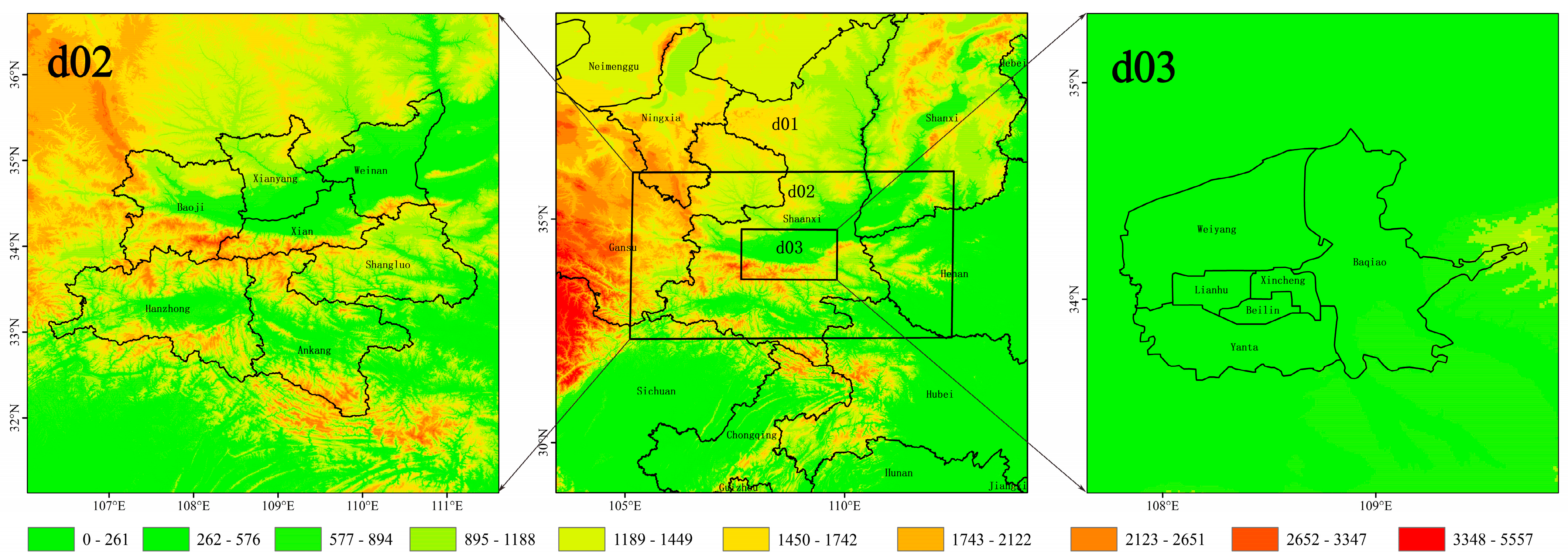


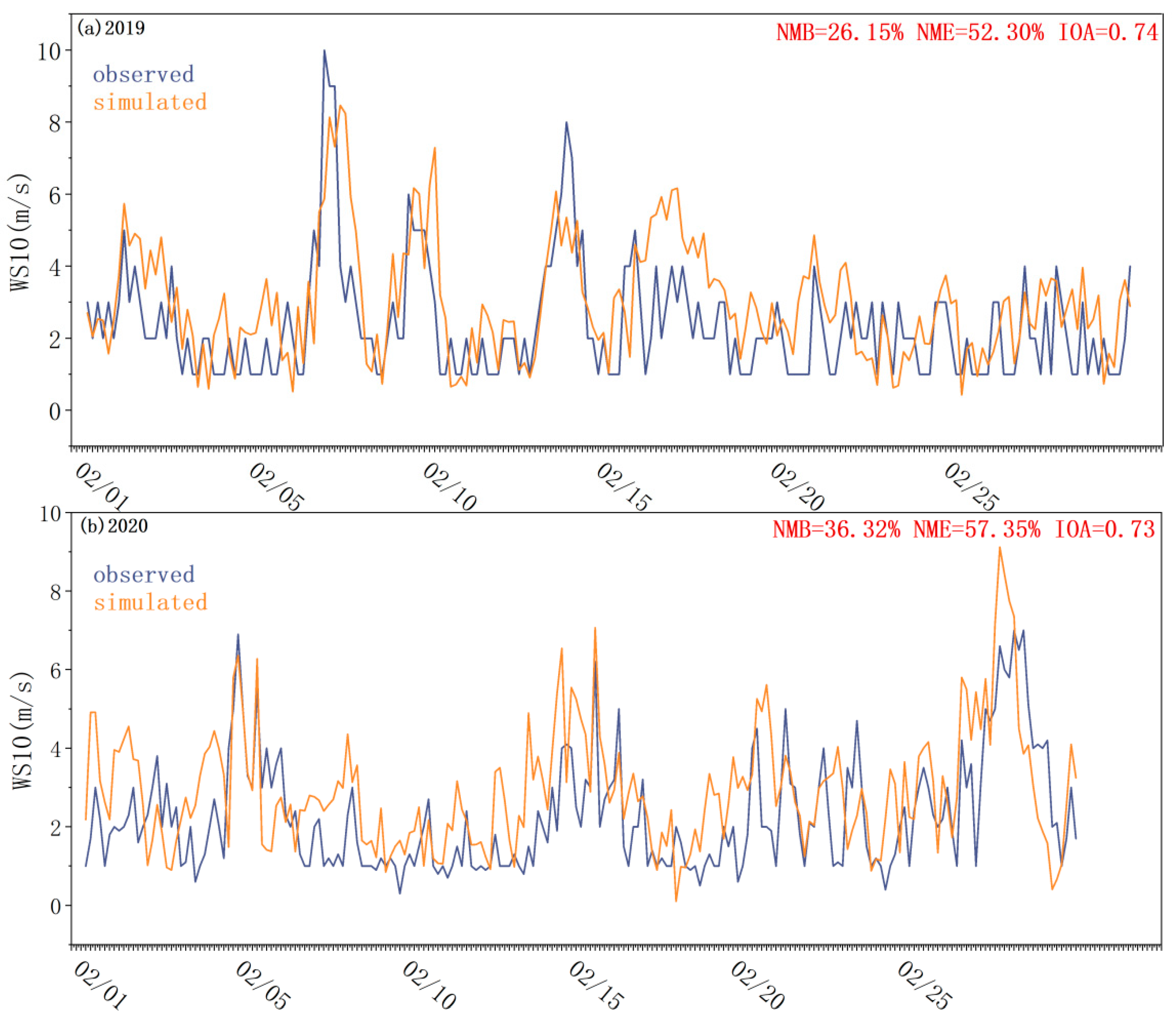

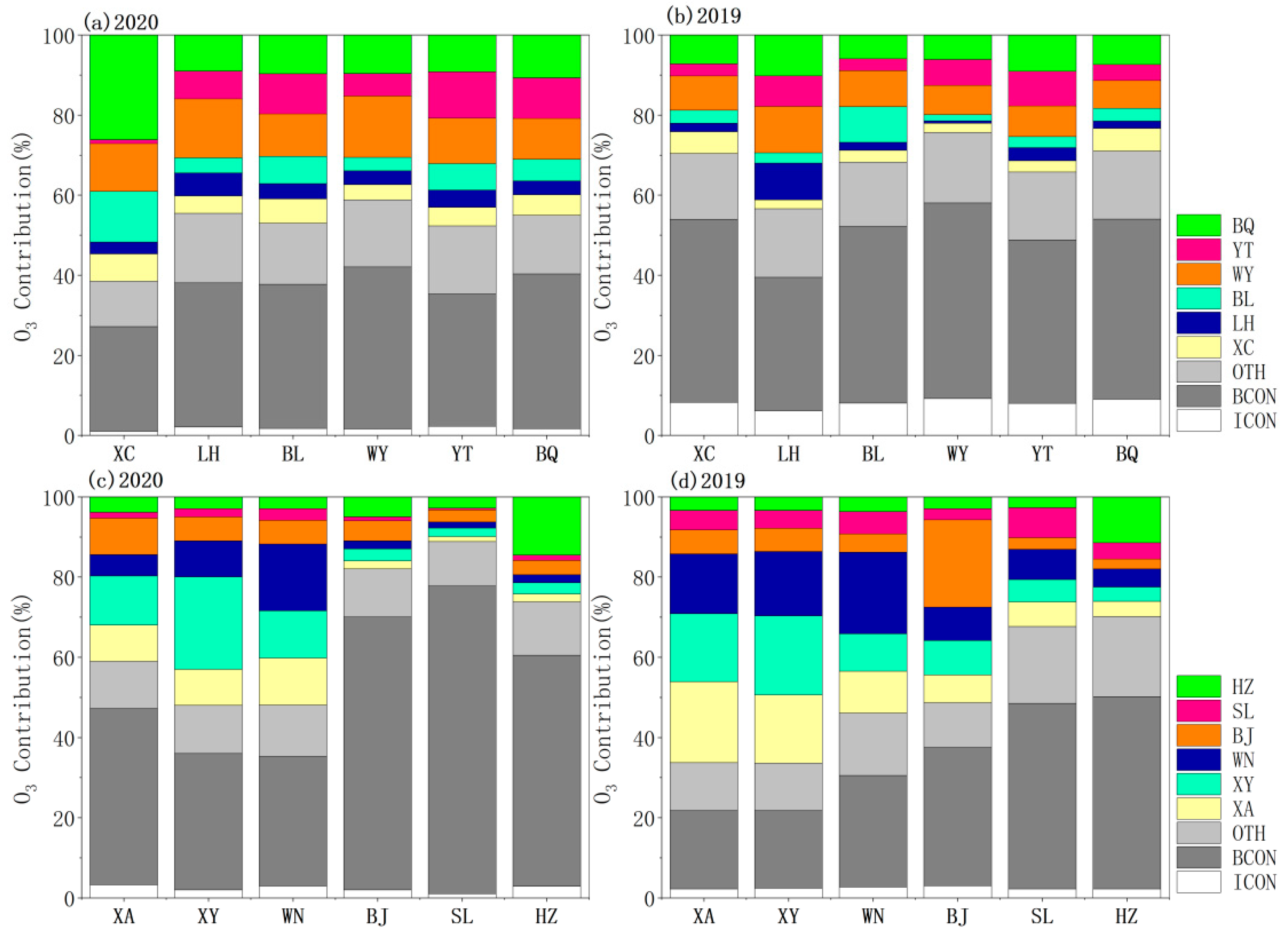
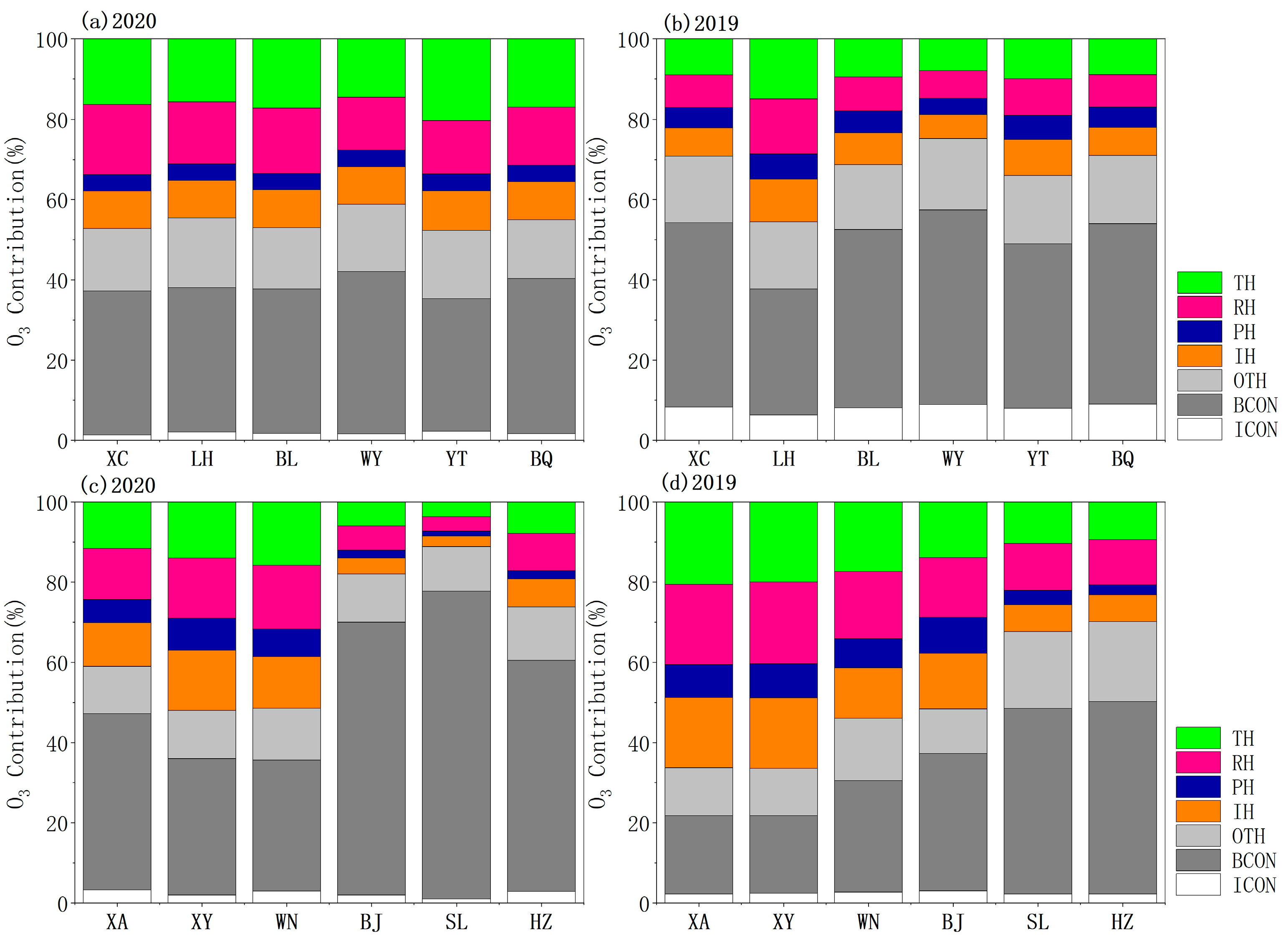

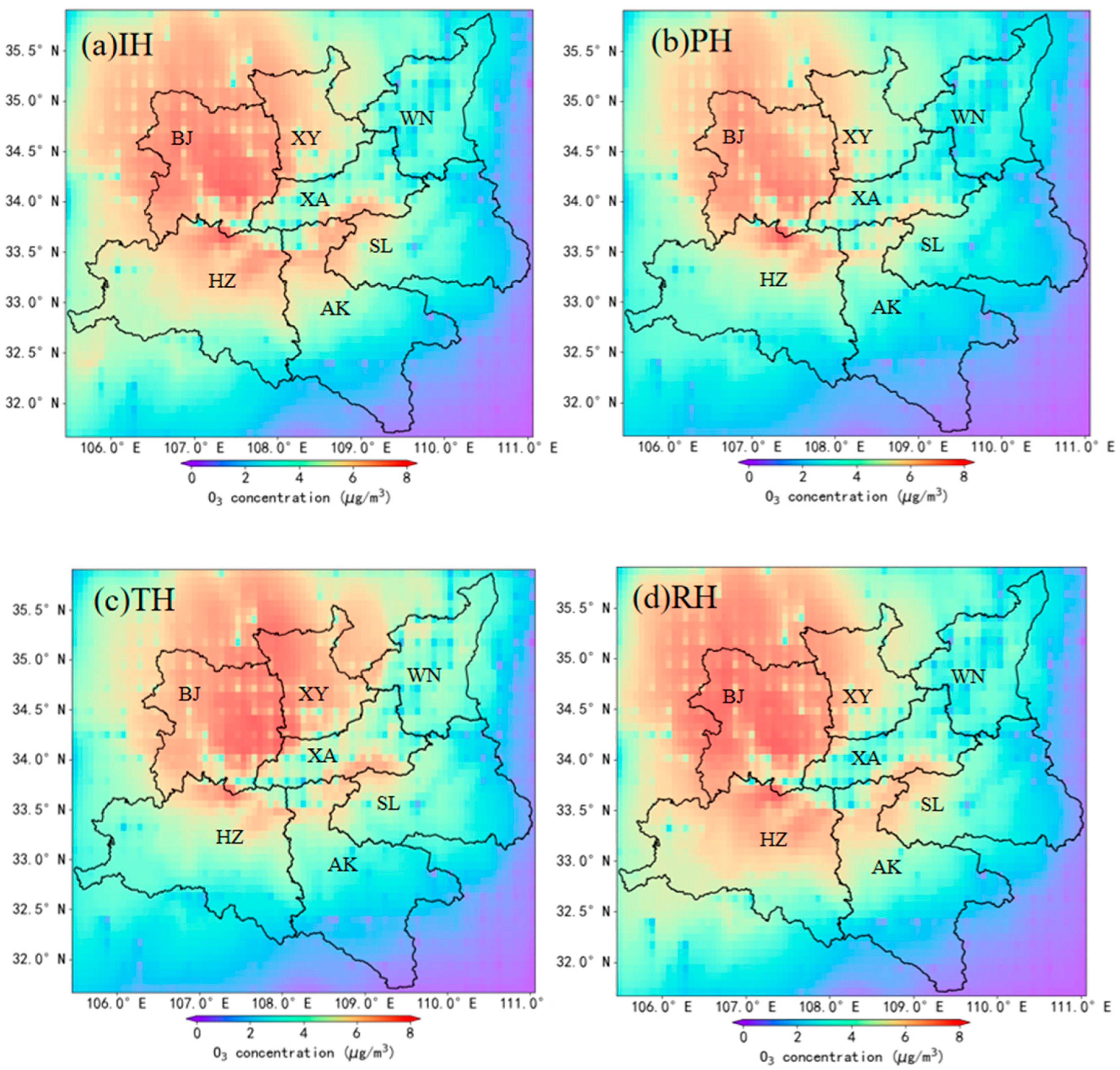
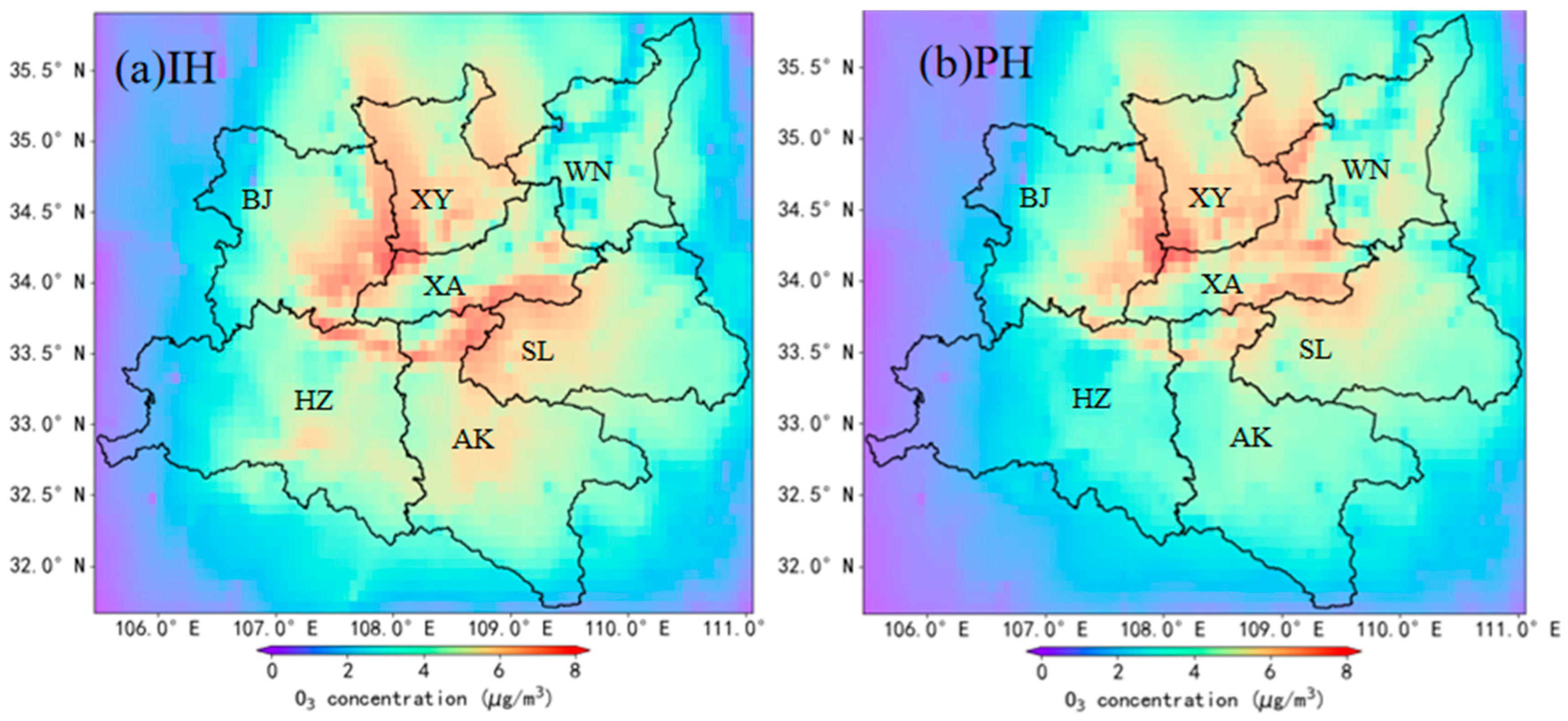
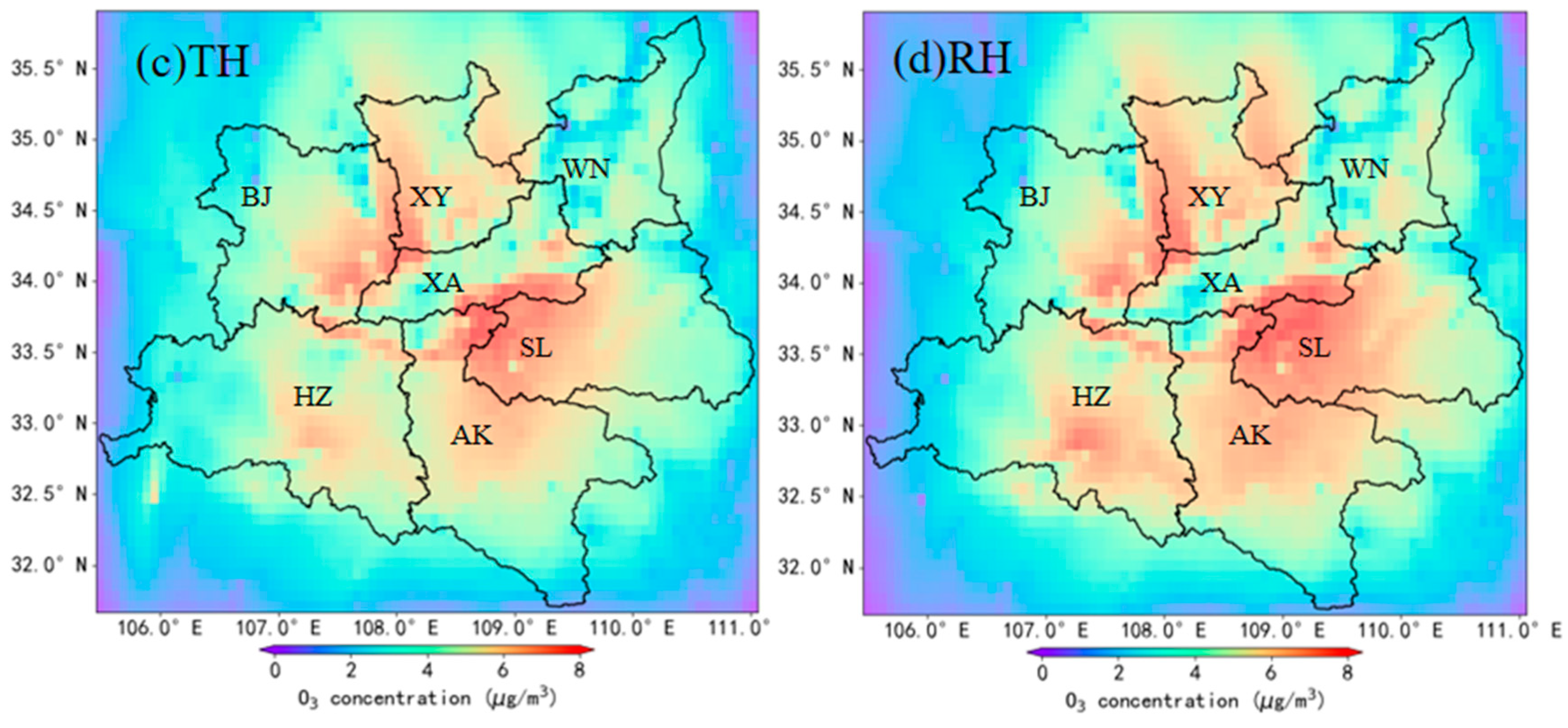


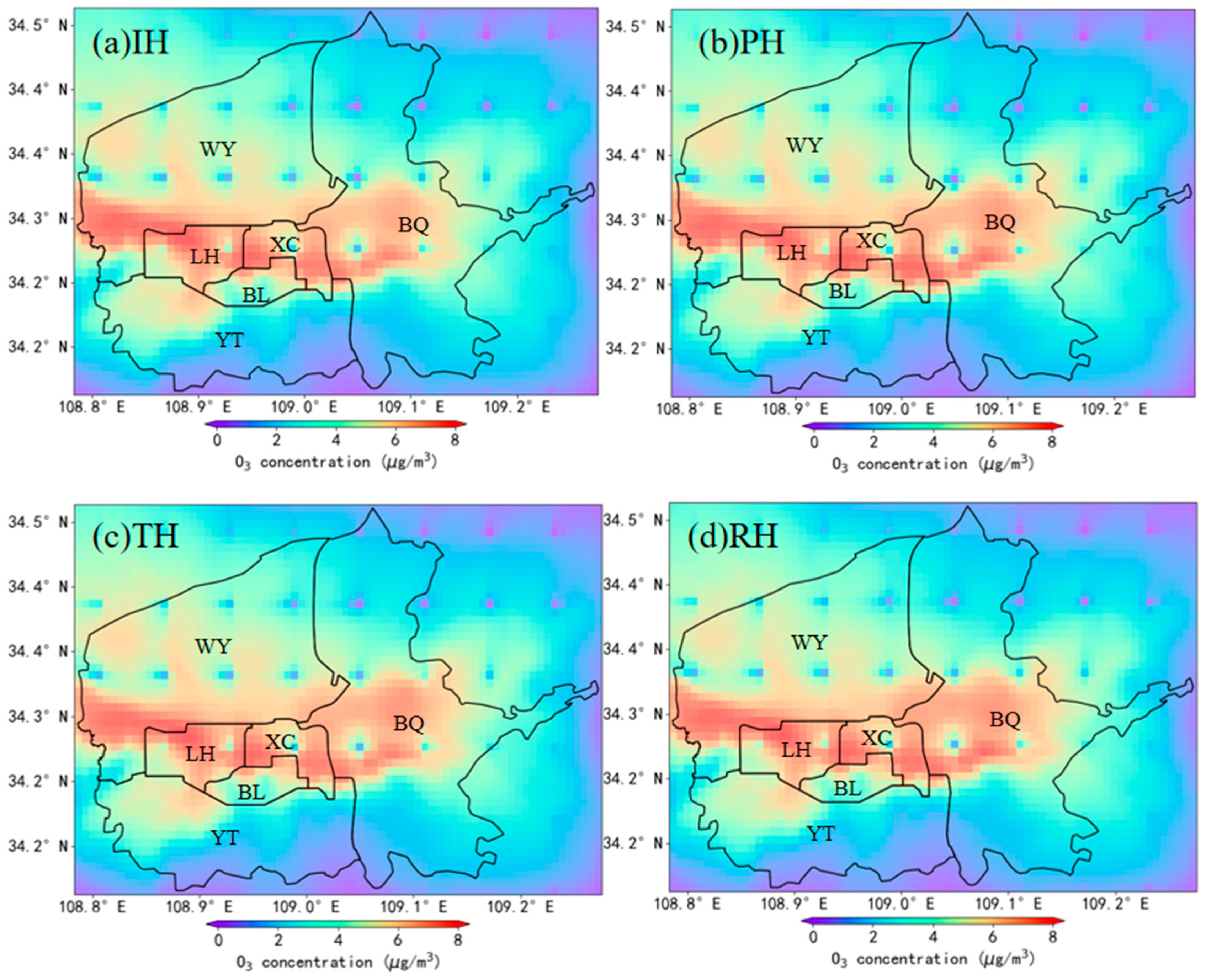
| Model | Model Attribution | Configuration |
|---|---|---|
| WRF | PBL physics scheme | YSU [30] |
| Surface-layer physics | Monin–Obukhov | |
| Land-surface model | Noah [31] | |
| Microphysics | WSM6 [32] | |
| Cumulus parameterization | Kain–Fritsch [33] | |
| Longwave radiation | RRTM [34] | |
| Shortwave radiation | Dudhia [35] | |
| CMAQ | Gas-phase chemistry | CB05 [36] |
| Month | Factor | NMB | NME | IOA | R |
|---|---|---|---|---|---|
| February 2019 | T2 (°C) | 34.23% | 37.47% | 0.96 | 0.97 |
| WS10 (m/s) | 26.15% | 52.30% | 0.74 | 0.60 | |
| February 2020 | T2 (°C) | 5.83% | 38.96% | 0.91 | 0.76 |
| WS10 (m/s) | 36.32% | 57.35% | 0.73 | 0.61 |
| Month | Pollutant | MFB | MFE | IOA | R |
|---|---|---|---|---|---|
| February 2019 | O3 | −3.675% | 55.63% | 0.79 | 0.67 |
| February 2020 | O3 | 11.64% | 47.85% | 0.62 | 0.43 |
| Tag Type | O3 |
| Tagged regions (d03) | Xincheng District (XC), Lianhu District (LH), Weiyang District (WY), Beilin District (BL), Baqiao District (BQ), and Yanta District (YT) |
| Tagged regions (d02) | Xi’an city (XA), Xiyang city (XY), Weinan city (WN), Baoji city (BJ), Shangluo city (SL), and Hanzhong city (HZ) |
| Tagged industries | Industrial (IH), power (PH), residential (RH), and transportation (TH) |
| Tagged source items | Initial conditions (ICONs), boundary conditions (BCONs), and default emission sources not explicitly labeled in the model (OTH) |
Disclaimer/Publisher’s Note: The statements, opinions and data contained in all publications are solely those of the individual author(s) and contributor(s) and not of MDPI and/or the editor(s). MDPI and/or the editor(s) disclaim responsibility for any injury to people or property resulting from any ideas, methods, instructions or products referred to in the content. |
© 2024 by the authors. Licensee MDPI, Basel, Switzerland. This article is an open access article distributed under the terms and conditions of the Creative Commons Attribution (CC BY) license (https://creativecommons.org/licenses/by/4.0/).
Share and Cite
Wang, J.; Cai, Y.; Zou, S.; Zhou, X.; Fang, C. Source Attribution Analysis of an Ozone Concentration Increase Event in the Main Urban Area of Xi’an Using the WRF-CMAQ Model. Atmosphere 2024, 15, 1208. https://doi.org/10.3390/atmos15101208
Wang J, Cai Y, Zou S, Zhou X, Fang C. Source Attribution Analysis of an Ozone Concentration Increase Event in the Main Urban Area of Xi’an Using the WRF-CMAQ Model. Atmosphere. 2024; 15(10):1208. https://doi.org/10.3390/atmos15101208
Chicago/Turabian StyleWang, Ju, Yuxuan Cai, Sainan Zou, Xiaowei Zhou, and Chunsheng Fang. 2024. "Source Attribution Analysis of an Ozone Concentration Increase Event in the Main Urban Area of Xi’an Using the WRF-CMAQ Model" Atmosphere 15, no. 10: 1208. https://doi.org/10.3390/atmos15101208
APA StyleWang, J., Cai, Y., Zou, S., Zhou, X., & Fang, C. (2024). Source Attribution Analysis of an Ozone Concentration Increase Event in the Main Urban Area of Xi’an Using the WRF-CMAQ Model. Atmosphere, 15(10), 1208. https://doi.org/10.3390/atmos15101208






